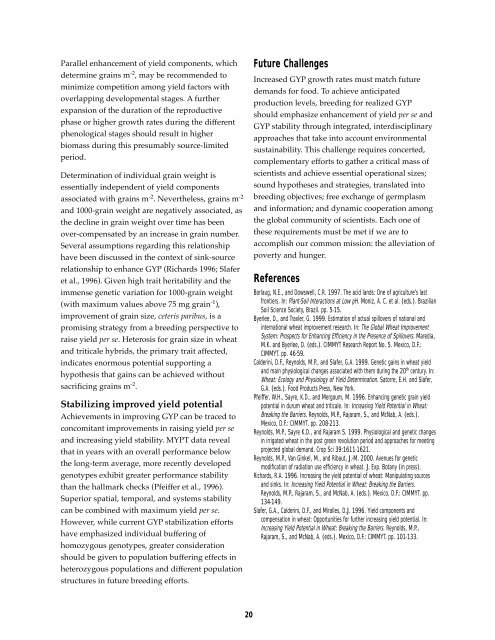Research Highlights of the CIMMYT Wheat Program 1999-2000
Research Highlights of the CIMMYT Wheat Program 1999-2000
Research Highlights of the CIMMYT Wheat Program 1999-2000
Create successful ePaper yourself
Turn your PDF publications into a flip-book with our unique Google optimized e-Paper software.
Parallel enhancement <strong>of</strong> yield components, which<br />
determine grains m -2 , may be recommended to<br />
minimize competition among yield factors with<br />
overlapping developmental stages. A fur<strong>the</strong>r<br />
expansion <strong>of</strong> <strong>the</strong> duration <strong>of</strong> <strong>the</strong> reproductive<br />
phase or higher growth rates during <strong>the</strong> different<br />
phenological stages should result in higher<br />
biomass during this presumably source-limited<br />
period.<br />
Determination <strong>of</strong> individual grain weight is<br />
essentially independent <strong>of</strong> yield components<br />
associated with grains m -2 . Never<strong>the</strong>less, grains m -2<br />
and 1000-grain weight are negatively associated, as<br />
<strong>the</strong> decline in grain weight over time has been<br />
over-compensated by an increase in grain number.<br />
Several assumptions regarding this relationship<br />
have been discussed in <strong>the</strong> context <strong>of</strong> sink-source<br />
relationship to enhance GYP (Richards 1996; Slafer<br />
et al., 1996). Given high trait heritability and <strong>the</strong><br />
immense genetic variation for 1000-grain weight<br />
(with maximum values above 75 mg grain -1 ),<br />
improvement <strong>of</strong> grain size, ceteris paribus, is a<br />
promising strategy from a breeding perspective to<br />
raise yield per se. Heterosis for grain size in wheat<br />
and triticale hybrids, <strong>the</strong> primary trait affected,<br />
indicates enormous potential supporting a<br />
hypo<strong>the</strong>sis that gains can be achieved without<br />
sacrificing grains m -2 .<br />
Stabilizing improved yield potential<br />
Achievements in improving GYP can be traced to<br />
concomitant improvements in raising yield per se<br />
and increasing yield stability. MYPT data reveal<br />
that in years with an overall performance below<br />
<strong>the</strong> long-term average, more recently developed<br />
genotypes exhibit greater performance stability<br />
than <strong>the</strong> hallmark checks (Pfeiffer et al., 1996).<br />
Superior spatial, temporal, and systems stability<br />
can be combined with maximum yield per se.<br />
However, while current GYP stabilization efforts<br />
have emphasized individual buffering <strong>of</strong><br />
homozygous genotypes, greater consideration<br />
should be given to population buffering effects in<br />
heterozygous populations and different population<br />
structures in future breeding efforts.<br />
Future Challenges<br />
Increased GYP growth rates must match future<br />
demands for food. To achieve anticipated<br />
production levels, breeding for realized GYP<br />
should emphasize enhancement <strong>of</strong> yield per se and<br />
GYP stability through integrated, interdisciplinary<br />
approaches that take into account environmental<br />
sustainability. This challenge requires concerted,<br />
complementary efforts to ga<strong>the</strong>r a critical mass <strong>of</strong><br />
scientists and achieve essential operational sizes;<br />
sound hypo<strong>the</strong>ses and strategies, translated into<br />
breeding objectives; free exchange <strong>of</strong> germplasm<br />
and information; and dynamic cooperation among<br />
<strong>the</strong> global community <strong>of</strong> scientists. Each one <strong>of</strong><br />
<strong>the</strong>se requirements must be met if we are to<br />
accomplish our common mission: <strong>the</strong> alleviation <strong>of</strong><br />
poverty and hunger.<br />
References<br />
Borlaug, N.E., and Dowswell, C.R. 1997. The acid lands: One <strong>of</strong> agriculture’s last<br />
frontiers. In: Plant-Soil Interactions at Low pH. Moniz, A. C. et al. (eds.). Brazilian<br />
Soil Science Society, Brazil. pp. 5-15.<br />
Byerlee, D., and Traxler, G. <strong>1999</strong>. Estimation <strong>of</strong> actual spillovers <strong>of</strong> national and<br />
international wheat improvement research. In: The Global <strong>Wheat</strong> Improvement<br />
System: Prospects for Enhancing Efficiency in <strong>the</strong> Presence <strong>of</strong> Spillovers. Maredia,<br />
M.K. and Byerlee, D. (eds.). <strong>CIMMYT</strong> <strong>Research</strong> Report No. 5. Mexico, D.F.:<br />
<strong>CIMMYT</strong>. pp. 46-59.<br />
Calderini, D.F., Reynolds, M.P., and Slafer, G.A. <strong>1999</strong>. Genetic gains in wheat yield<br />
and main physiological changes associated with <strong>the</strong>m during <strong>the</strong> 20 th century. In:<br />
<strong>Wheat</strong>: Ecology and Physiology <strong>of</strong> Yield Determination. Satorre, E.H. and Slafer,<br />
G.A. (eds.). Food Products Press, New York.<br />
Pfeiffer, W.H., Sayre, K.D., and Mergoum, M. 1996. Enhancing genetic grain yield<br />
potential in durum wheat and triticale. In: Increasing Yield Potential in <strong>Wheat</strong>:<br />
Breaking <strong>the</strong> Barriers. Reynolds, M.P., Rajaram, S., and McNab, A. (eds.).<br />
Mexico, D.F.: <strong>CIMMYT</strong>. pp. 208-213.<br />
Reynolds, M.P., Sayre K.D., and Rajaram S. <strong>1999</strong>. Physiological and genetic changes<br />
in irrigated wheat in <strong>the</strong> post green revolution period and approaches for meeting<br />
projected global demand. Crop Sci 39:1611-1621.<br />
Reynolds, M.P., Van Ginkel, M., and Ribaut, J.-M. <strong>2000</strong>. Avenues for genetic<br />
modification <strong>of</strong> radiation use efficiency in wheat. J. Exp. Botany (in press).<br />
Richards, R.A. 1996. Increasing <strong>the</strong> yield potential <strong>of</strong> wheat: Manipulating sources<br />
and sinks. In: Increasing Yield Potential in <strong>Wheat</strong>: Breaking <strong>the</strong> Barriers.<br />
Reynolds, M.P., Rajaram, S., and McNab, A. (eds.). Mexico, D.F.: <strong>CIMMYT</strong>. pp.<br />
134-149.<br />
Slafer, G.A., Calderini, D.F., and Miralles, D.J. 1996. Yield components and<br />
compensation in wheat: Opportunities for fur<strong>the</strong>r increasing yield potential. In:<br />
Increasing Yield Potential in <strong>Wheat</strong>: Breaking <strong>the</strong> Barriers. Reynolds, M.P.,<br />
Rajaram, S., and McNab, A. (eds.). Mexico, D.F.: <strong>CIMMYT</strong>. pp. 101-133.<br />
20

















